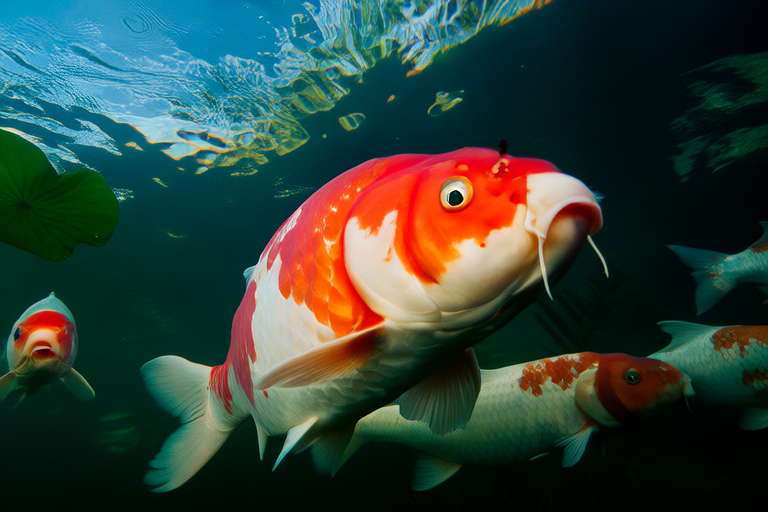The Ultimate Guide to Keeping Your Koi Healthy and Happy
Keeping koi fish is a rewarding hobby that can bring joy and tranquility to your life. However, it requires dedication and knowledge to ensure that these colorful and fascinating creatures thrive in their environment. This comprehensive guide will cover everything you need to know about maintaining healthy and happy koi, from water quality and diet to pond setup and seasonal care.
Optimal Water Quality Parameters
Water quality is paramount for the health of your koi. The following parameters are crucial:
- pH Levels: Maintain a pH between 7.2 and 8.0. Test the water regularly and adjust with appropriate chemicals if necessary.
- Ammonia and Nitrite Levels: Both should be undetectable. Use a test kit to monitor levels and consider adding beneficial bacteria or performing partial water changes if levels rise.
- Nitrate Levels: Keep nitrate levels below 50 ppm. Regular water changes are essential to control nitrates.
- Temperature: Koi prefer temperatures between 68°F and 74°F (20°C and 23°C). Avoid sudden temperature fluctuations.
- Dissolved Oxygen: Ensure there is sufficient oxygen by incorporating aeration devices like waterfalls, fountains, or air pumps.
Suitable Diet for Koi
A balanced diet is key to keeping your koi healthy. Their nutritional needs change with the seasons:
- Spring: Feed them a high-protein diet to aid recovery from winter.
- Summer: Opt for a balanced diet that includes protein, carbohydrates, and fats.
- Fall: Gradually reduce feeding as the temperature drops.
- Winter: Stop feeding when the water temperature falls below 50°F (10°C).
Feed your koi small amounts frequently rather than large meals once a day. Monitor their eating habits to avoid overfeeding, which can lead to poor water quality.
Common Health Issues and Prevention Methods
Like any pet, koi are susceptible to various health problems. Here are some common issues and how to prevent them:
- Fungal Infections: These appear as white spots on the fish’s body. Prevent by maintaining good water quality and avoiding overcrowding. Treat with antifungal medications if necessary.
- Bacterial Infections: Symptoms include redness, ulcers, and lethargy. Good water quality and quarantine of new arrivals help prevent infections. Consult a veterinarian for treatment options.
- Parasitic Infestations: Look for signs like rubbing against objects, rapid breathing, and white spots. Regular treatments with anti-parasitic medications can help prevent infestations.
Ideal Pond Setup and Maintenance
A well-designed pond provides a safe and comfortable environment for your koi. Consider the following:
- Pond Size: A minimum volume of 1,000 gallons (3,785 liters) per koi is recommended to ensure they have enough space to swim freely.
- Depth: Aim for a depth of at least 3 feet (0.9 meters) to provide a stable temperature and protection from predators.
- Filters: Install biological and mechanical filters to maintain clean water. Clean filters regularly to prevent clogs and ensure efficient filtration.
- Plants: Aquatic plants offer shade, oxygenate the water, and provide hiding places. Choose species that thrive in your pond’s conditions.
Seasonal Care Tips
Adjusting your pond management practices according to the season helps maintain your koi’s health:
- Spring: Perform a thorough cleaning of the pond, including filters and pumps. Check for any signs of disease or parasites. Increase feeding gradually as the water warms up.
- Summer: Monitor water quality closely and perform frequent water changes if needed. Provide additional aeration during hot weather. Ensure that your koi have plenty of shade.
- Fall: Reduce feeding as the temperature cools down. Prepare the pond for winter by checking equipment and ensuring it is functioning properly.
- Winter: Minimize disturbances to the pond. If necessary, install a de-icer to keep a hole open for gas exchange. Continue monitoring water quality to prevent ammonia buildup.
The Importance of Regular Observation and Interaction
Regularly observing your koi allows you to notice any changes in behavior or appearance early, enabling prompt intervention if needed. Spend time interacting with your koi; they can become quite responsive to their caretakers.
When observing your koi, look for signs of stress or illness such as:
- Lethargy or lack of appetite
- Unusual swimming patterns
- Visible injuries or discoloration
- Increased respiration rate
Additionally, pay attention to social interactions within the pond. Bullying or aggressive behavior among koi can cause stress and injury. If necessary, separate aggressive individuals to prevent further harm.
In conclusion, keeping koi healthy and happy involves more than just providing food and water. By understanding their specific needs and addressing potential challenges proactively, you can enjoy a thriving pond ecosystem full of vibrant and lively koi. Remember, patience and consistent effort are key to successful koi keeping.
